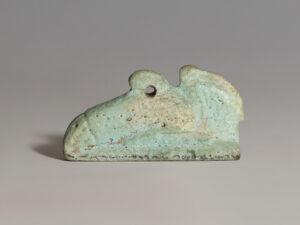Amulets held different meanings, depending on their type or form. Small amulets depicting gods and goddesses seem to have induced the protective powers of the deity. On the other hand, small representations of anatomical features or creatures suggest that the wearer required protection over a specific body part, or that he/she desired the skills of a particular animal. Amulets depicting animals were very common in the Old Kingdom Period, whilst representations of deities gained popularity in the Middle Kingdom.
Khnum is most frequently depicted with a ram’s head, as he is in this example. He was one of the earliest deities to be celebrated in Egypt, and was originally the god of the source of the river Nile. He was also a god of birth and creation, as it was believed that Khnum made babies out of clay, using his potter’s wheel, and placed them in their mother’s wombs. The river Nile, rich in nutrients and good soil, was a wonderful source of life and sustenance. Khnum was therefore known as a protector and guardian, especially in relation to children – hence the choice for his depiction on an amulet.
To find out more about the Ancient Egyptian amulets, please see our relevant blog post: Egyptian Amulets and their Meanings: Ancient Egyptian Gods



















